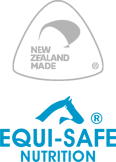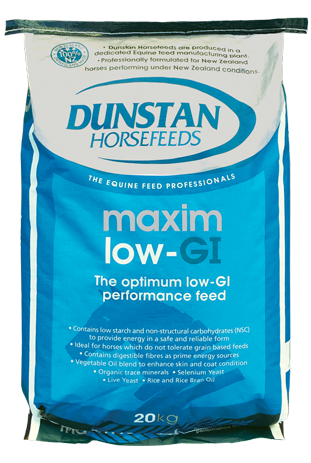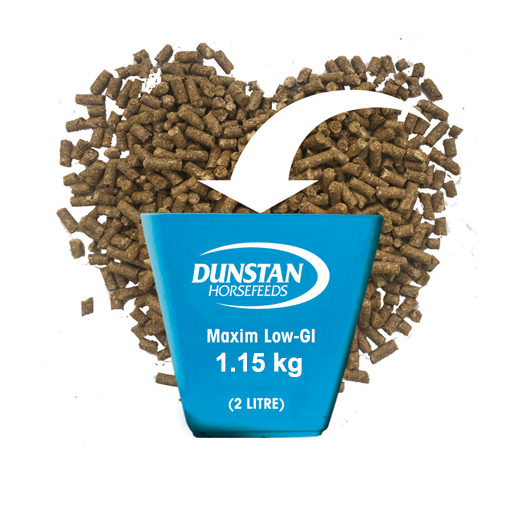- Dunstan Maxim Low-GI is premium quality, Low-GI performance feed.
It is formulated using quality fibre sources to produce a feed that is low in starch and sugar, suitable for horses that get ‘hot’ on conventional grain-based feeds.
The quality fibre sources included in Dunstan Maxim Low-GI, ( Sugarbeet, Lucerne, Soya Hulls and Meadow Hay) result in a high-fibre feed which has benefits for equine digestive health and they also assist in contributing to the horses daily fibre requirements. The addition of a Live Yeast further contributes to digestive health, as it aids digestion and assists in maintaining a more optimal hindgut pH, therefore contributing to the overall health of the intestinal ecosystem of the horse.
The inclusion of Vegetable Oil provides a ‘cool energy’ sources as well as providing essential fatty acids for coat sheen and skin condition.
The inclusion of Glycinate Trace Minerals and Selenium Yeast ensure maximum availability of these important minerals. Combined with elevated levels of Natural Vitamin E, the highly bio-available Organic Selenium assists to maintain normal muscle function and together they act as antioxidants to protect body tissues from oxidative stress.
Mannan Oligosaccharide and Aluminosilicate Clay are included in Dunstan Maxim Low-GI to aid in digestive comfort.Equine Safe
Dunstan Horse Feeds are produced in Equine-Safe manufacturing plants, ensuring a product of premium quality, safety and performance.
Professionally formulated for New Zealand Horses performing under New Zealand conditions - Lucerne Meal, Sugarbeet, Bran and Pollard, Soya Bean Meal, Soya Hulls, Linseed Meal, Meadow Hay, Vegetable Oil, Limestone (for Calcium), Magnesium Oxide, Salt, Organic Glycinate Trace Minerals, Selenium Yeast, Vitamins, Natural Vitamin E, Live Yeast, Amino Acids, Molasses, Mannan Oligosaccharide and Aluminosilicate Clay
Typical Analysis (approximate on a dry matter Basis)
| Crude Protein | 17.0% |
| Fat | 6.5% |
| Fibre | 20% |
| Salt | 1.5% |
| DE Energy | 13.0MJ/kg |
Nutrient Composition - typical analysis per kg of Dunstan Maxim Low-GI (as fed)
| Crude Protein | 148g |
| Lysine | 7.0g |
| Starch | 60g |
| Calcium | 12g |
| Phosphorus | 6.0g |
| Sodium | 6.0g |
| Chloride | 8.0g |
| Potassium | 14g |
| Magnesium | 7.5g |
| Iron | 300mg |
| Zinc (Organic) | 160 mg |
| Manganese | 110 mg |
| Copper (Organic) | 70 mg |
| Cobalt | 0.8 mg |
| Iodine | 1.0 mg |
| Selenium (Organic) | 0.4mg |
| Vitamin A | 10,000 i.u |
| Vitamin D3 | 1,000 i.u |
| Vitamin E | 250 i.u |
| Vitamin K | 2.0mg |
| Thiamine B1 | 6.0mg |
| Riboflavin B2 | 6.0mg |
| Pyridoxine B6 | 5.0mg |
| Vitamin B12 | 50ug |
| Niacin | 20mg |
| Pantothenate | 10mg |
| Biotin | 100ug |
| Folic Acid | 1.5mg |
| Choline | 150mg |
Heat Stable Vitamins added at the time of manufacture
Amounts per horse per day when offered as the full feed:
The recommended feeding rates are based on a 500kg horse and are guidelines only.
| Maintenance/Spelling | 2kg |
| Light work | 3kg-4kg |
| Medium Work | 4kg-5kg |
| Heavy Work | 5kg-6kg |
- The recommended feeding rates for Dunstan Maxim Low-GI are based on a 500kg horse and are guidelines only. Daily feed amounts will vary depending on pasture availability and body condition. Horses are very much individuals with different metabolic efficiencies, some require a little more, others a little less, for the same level of activity.
- Ensure adequate fibre intakes by providing 1 % -1 .5% per day of the horse's body weight as chaff, hay, Dunstan Betabeet/Sugarbeet or pasture (on a Dry Matter basis).
- For good-doing mares in their last trimester, feed Dunstan Pasture Plus concentrate as a replacement for Dunstan Maxim Low-GI to ensure adequate mineral intake
- It is advisable to split the daily hard-feed into at least two feeds, preferably 3-4, but feed no more than 2.0 kg of Dunstan Maxim Low-GI per meal.
General Notes
Always ensure the Horse has access to clean drinking water. High Copper levels in Dunstan Maxim Low-GI make it unsuitable for feeding to sheep.
Dunstan Horsefeeds are best used within four months from the time of purchase.
This ensures the vitamins included in Dunstan Horsefeeds remains efficacious to ensure optimum equine health.
However, as is the case with human foods, “fresh is best”. So always aim to feed Dunstan products as fresh as you are able.
A Hint on Storage of Dunstan Horsefeeds:
When storing Dunstan Horsefeeds, it is important that it is kept in a clean, dry, cool and rodent-proof area to avoid potential moulds and/or contaminants.




